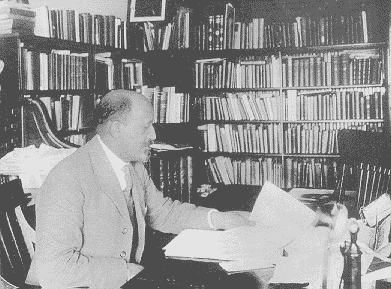Prof. Thornton Lockwood writes…

Du Bois at work in the office of The Crisis, c. 1915. Image from http://northbysouth.kenyon.edu.
In my CC204 lecture on race earlier this month, I raised the issue of the Historian’s fallacy, post hoc, ergo propter hoc (Latin for “after this, therefore because of this”), which consists in attributing a causal sequence between two events based on the fact that one event follows another. My lecture focused on the structural effects of American slavery, and when one reads Du Bois’ description of African Americans in 1880’s Georgia, in his essay “Of the Quest of the Golden Fleece,” there is no question that the debt peonage and fragile nature of former slave families he describes is the direct legacy of slavery. But are there social scientific phenomena today that can be traced to the slavery that existed in the United States 150 years ago? To probe that question, I had students look at a map of the 1860 federal census, which identified the per county percentage of slaves in the former Confederacy.
Next, I had students consider the incidence of obesity in the United States, which the Center for Disease Control chronicles by individual county. Although the two maps are not a perfect match, and there have been major demographic changes in American since the 1860’s—most importantly, the “Great Migrations” of African Americans from the Cotton Belt south to northern, Midwestern, and western urban centers in the 20th century—nonetheless, there is a whole host of social ills such as obesity, diabetes, illiteracy, domestic violence, and decreased life-expectancy whose distribution echoes demographic patterns found in the 1860 census. Causation, direct or indirect, or simple correlation? I’ll save discussion of those frequently misunderstood issues, for a future blog post.
*
NB: In view of the sesquicentenial of the American Civil War, The New York Times is running a blog entitled Disunion, which counts down the weekly events that happened in the U.S. 150 years ago today. It features Times columnists and major historians, and I strongly recommend it—including the blog entry which discusses the significance of the 1860 census map.
